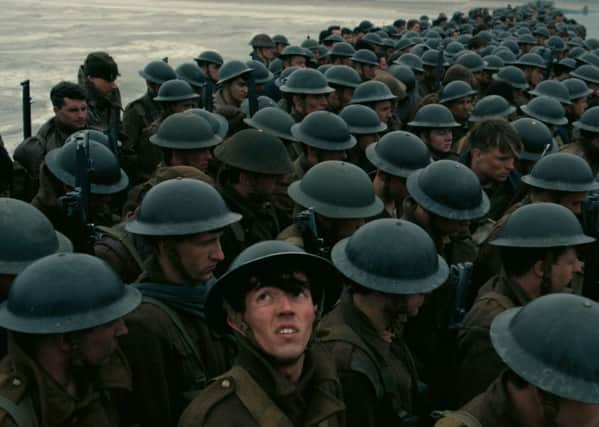Film reviews: Dunkirk | The Beguiled


Dunkirk (12A) *****
The Beguiled (15) ***
One of the many striking things about Dunkirk is how brilliantly Christopher Nolan redefines what epic cinema means. Contained rather than expansive, this is a film that uses scale to intensify the immediacy of the experience, not drag it out with endless money shots, meandering dialogue, rote flashbacks and needless character development. In keeping with the theme of a movie charting the desperate evacuation of 300,000 Allied troops from the beaches of Northern France, not a second is wasted in the taut 105-minute running time, something Nolan emphasizes by giving it the ticking-clock structure of a thriller, albeit a very Nolan-style thriller.
This starts the moment the film opens and only gets more urgent as he deploys an overlapping triple-timeline narrative device reminiscent of the one he used to exhilarating effect in the final act of Inception. Splitting Dunkirk’s plot along elemental lines as well, the film tells the story of the so-called “Dunkirk miracle” over the course of a week on the ground, a day on the sea and an hour in the air, with all three converging in intriguing and nerve-shredding ways as the movie progresses.
Advertisement
Hide AdThe first story is centred around the “The Mole”, the precarious jetty on Dunkirk beach where the British Navy, under the command of Kenneth Branagh’s steely Commander Bolton, are attempting to evacuate the thousands of troops who’ve been pushed back by the Germans and are now trapped on the French coast. The second story follows citizen sailor Mark Rylance and his two sons (Barry Koeghan and Nolan doppelgänger Tom Glynn-Carney) as they take part in the civilian flotilla launched by the government following the realisation that only small boats could get close enough to the beaches to get the troops off (though another reason is proffered later on for the lack of naval support). The third plot follows crack RAF Spitfire pilots Farrier (Tom Hardy) and Collins (Jack Lowden) as they crisscross the Channel, desperately short of fuel, but determined to take out as many German dive bombers as possible.
The dogfights are the closest the film gets to a traditional war movie. As Dunkirk opens on the deserted streets of the eponymous French town, it sets up its stall instead as a survival movie, but also as a disaster movie, one replete with overturned ships, mounting group tensions and bewildered resilience in the face of terrible carnage. Amidst the thousands of extras marshalled for the shoot, Nolan zeroes in on a few characters only and gives us just enough information to ensure our rapid investment in their fates. Yet he never loses sight of the human moments as he crosscuts between each strand. Shot using his preferred large format IMAX cameras (and the film really should be seen in IMAX if possible), Dunkirk’s immense scale doesn’t obliterate the actors with jaw-dropping spectacle. Instead, it makes them a fully-fledged part of that spectacle, which in turn makes the film all the more powerful as an immersive viewing experience.
That’s important too because a lot of the dialogue – perhaps by design – is almost incomprehensible, drowned out by the cacophony of artillery fire and the complex tonal arrangements of Hans Zimmer’s driving, percussive score, which blends engine sounds, ticking watches, shellfire and phrases from Elgar’s Nimrod into a continuous musical melee that’s as sonically unsettling as it is emotionally devastating. This also reinforces the point that actions speak louder than words in Dunkirk, something made even more poignant by Nolan’s mythology puncturing decision to have Churchill’s “Fight them on Beaches” speech delivered not via an audio recording of the man himself, but by a shell-shocked escapee reading it aloud from a newspaper upon his return from France. His jittery, passionless voice is a grim portent of the further sacrifices he and his fellow survivors will be expected to make. What a film.
Revolving around an injured Union soldier hiding out in a girls’ boarding school in the South during the dying days of the Civil War, Sofia Coppola’s take on The Beguiled is a far more subdued adaptation of Thomas Cullinan’s pulp novel than the 1971 Clint Eastwood version. That was more of a trippy horror movie and was unambiguous from the off about Eastwood’s villainous status. In Coppola’s version, Colin Farrell plays the soldier with the vulnerability of a wounded puppy, which changes the dynamic considerably when he’s taken in by Nicole Kidman’s headmistress and her students. Presenting the story from the point of view of her female protagonists, Coppola uses their cloistered position to explore the simmering sexual jealousies that emerge when this stranger comes into their midst. Kidman, Kirsten Dunst (as the girls repressed French teacher) and Elle Fanning (as the most sexually curious of the girls) do strong work here, suggesting entire histories for their characters with furtive glances. And yet in its determination to avoid camp, the film is almost too tasteful. It’s also pretty vague about the wider implications of its setting. Though the fortress-like plantation in which the school is housed serves as a creepy signifier of the Civil War’s underlying causes, Coppola never acknowledges the issue of slavery directly, even excising the one black character that featured in both the book and earlier film version. Nevertheless, in its own woozy, evocative, aesthetically beautiful way, the film does feel like it’s getting at something interesting about the dangers of trying to preserve a moribund way of life at all cost.